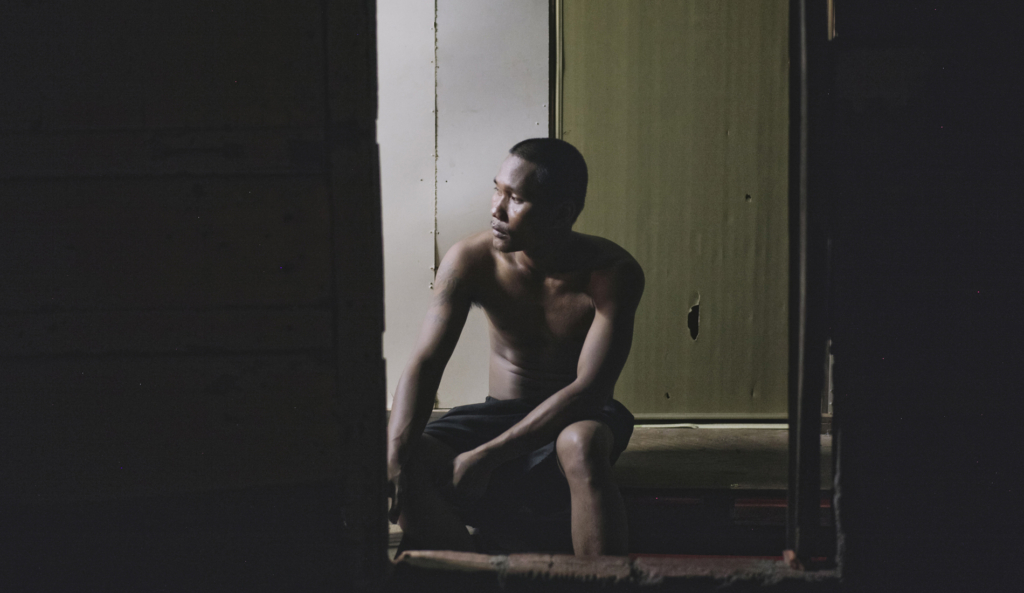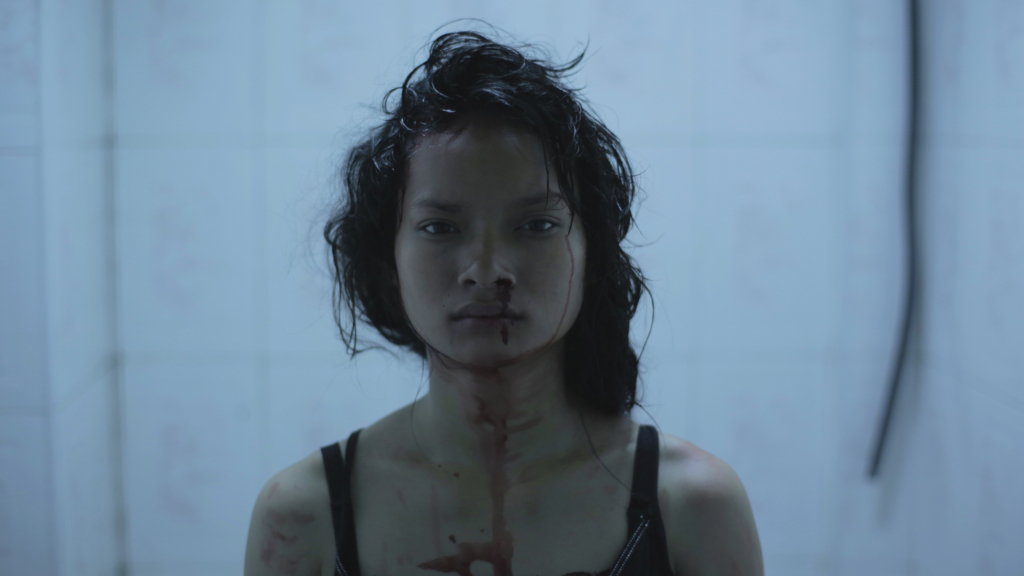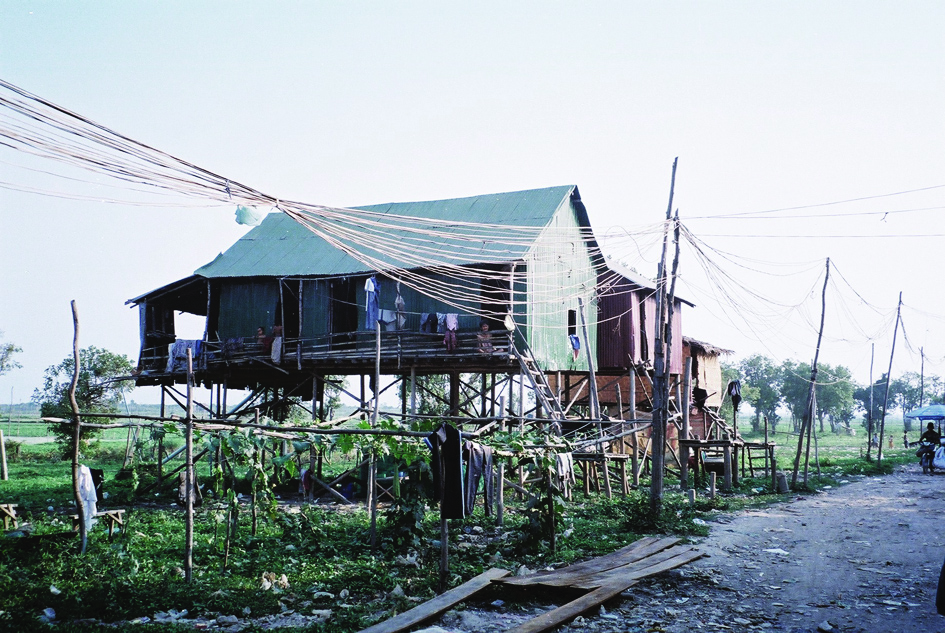We dive and reappear in new places.
— Ralph Waldo Emerson
I arrive at the Ruin (Amiel Courtin-Wilson & Michael Cody, 2013) production office on Street 172. It takes up over three storeys of a hotel called Super Star. It’s only a few days before the shoot starts and a large proportion of the cast still needs to be filled. Having previously done street-casting for Hail (Amiel Courtin-Wilson, 2011, produced by Michael Cody), I’m assigned the task of filling the more ‘difficult’ roles – criminals, pimps, prostitutes, drug dealers, drug addicts, gangsters. Out the front of Super Star, casting director Kate Laurie introduces me to a tuk-tuk driver and a translator named Luc. Luc asks where we’re going and, with the brief in mind, I stupidly say, ‘Take me to the most dangerous part of Phnom Penh.’ Luc shakes his head and responds, ‘I learnt English so that I wouldn’t have to deal with these kinds of people.’
We soon arrive at one of the city’s largest garbage dumps, where a shanty town houses thousands of residents in makeshift scrap huts atop tons of rubbish. I walk on thin wooden planks through the village and repeatedly hear the word barang called out through laughter – it’s a Khmer word that’s recently been used to mean ‘foreigner’ or ‘white person’. The air swelters through the bustling ghetto. Residents chat over condensed-milk coffee and bowls of rice soup or the odd delicacy of balut – a partially formed duck embryo that is cooked alive in its shell and releases a stench far worse than that of the piles of garbage.
A man with immaculately white tracksuit pants, a white tank top, gold necklaces and a gold tooth rocks in an armchair. ‘My friends, what you do here?’ he asks. Luc tells him that we’re casting for a film. He says that he’s a good boxer and, therefore, he’ll be able to act. We take down the number of one of his many mobile phones and he proceeds to escort us around the dump – it quickly becomes clear that he’s an overseer (of sorts) of the slum. He picks up a metal rod off of the scrap heap. He hits it against one of the shanties and calls out a name. A young man sticks his head out of one of the jagged cavities of his tin shack. Our escort coaxes him out and tries to lift up his shirt. The man swipes at the hands trying to show his chest, but he eventually gives in. A deeply stitched and stapled knife wound runs as a thick seam from his bellybutton to his sternum. He explains to Luc that he did it to himself during a psychotic episode while high on yama – a street drug similar to crystal meth, which is crudely made by cooking various prescription drugs with chemicals and agents such as kerosene, ammonia, sulphuric acid, potassium permanganate and diesel fuel. When he was high, the man became deluded, convinced that there was a bird inside his stomach. He smashed an empty beer bottle on the street and tried to disembowel himself to let the bird out.

Another man emerges from the next-door shack, wanting in on the attention his neighbours are attracting, and banters about. Luc’s face is a cocktail of childlike surprise and horror. He translates what the man is saying: ‘I acted before. I acted once. I played a rapist.’
Moving deeper into the dump, a family of four see us traipsing through their village and pull back the curtains covering the holes of their tin walls and hide. ‘They don’t want you to see – they all have HIV,’ Luc explains.
A tall man is yelling through the slum. He wears a one-piece bathing suit over a spray jacket, a pair of board shorts and a large bumbag. He stands up straight and raises his palm to his brow and repeatedly salutes me. An old woman with a wig and stained red stumps of teeth creeps up behind the man, raises her arm and motions to split his skull with a meat clever she has pulled out from under her dress. She drops the cleaver and laughs among the twisted wreckage.
‘Being in a relationship unearths worlds of swallowed grief and anger that neither can assimilate – the trauma is expressed in various ways at this point of encountering the other in the most intimate way.’
– Michael Cody
As I leave, a young boy who can be no older than twelve runs up and hugs me around my legs. He looks up at me, smiling, with his eyes rolling to white and looking towards the back of his head. He clutches a splattered plastic bag. A can of glue is held to his hip by the elastic band of his underwear.
I get back into the tuk-tuk and travel to our next casting spot: Korsang, a non-government organisation that rehabilitates drug users and HIV victims. There, we are to meet a young man who wants to try acting to overcome his heroin addiction. We pick him and his wife up in our tuk-tuk and return to Super Star. I slump onto a mattress, spent from the heat and from the immensity of the accounts that I’ve only shallowly waded through in my first three hours in Cambodia.

The inception of Ruin was wildly open, fragile and vibrant – banking on a collective avidity to continually find the film. Instead of a script, there was a vivid prose treatment that changed daily, accompanied by a dizzying slew of references: the works of audiovisual artist Philippe Grandrieux and materialist filmmakers such as Peter Tscherkassky, Gunvor Nelson’s My Name Is Oona (1969), Lautréamont’s late 1860s poetic novel Les chants de Maldoror, the photography of Antoine D’Agata and, of course, the unjointed backdrop of Cambodia itself. Close to a year and a half after the production, I speak to the film’s directors to try and unpack Ruin from these many-hued nascent stages through to the film’s completion. Cody details:
I first went to Cambodia as a foreign correspondent making documentary-style pieces, and in the course of doing that I discovered that the most perplexing things about the place didn’t fit into a half-hour current-affairs documentary format, so I thought it would be more interesting in some sort of drama context. After going to Venice with Hail, Amiel and I were chatting about it. I was planning to go there – I had a little bit of development money for a project that was fairly amorphous. Amiel decided to come along. We arrived there and went into a very intensive research process. We started meeting all these people and interviewed them extensively for their stories, which sometimes folded into the treatment. We started writing a couple of different stories and finally settled on this love story.
Courtin-Wilson adds:
In the very early days we were very taken by a number of people we were meeting, so we thought about it being a very kaleidoscopic structure similar to something like Sans soleil [Chris Marker, 1983]. Something very dense and incorporating a lot more factual information to do with the trials going on at the time – the UN trials for the Khmer Rouge. But I think it was really when we met [Rous] Mony, our lead actor, that it was so clear that his strength as a performer was streets ahead of a lot of the other actors we were meeting. It was then that the road-movie structure of the film came into being – at least in its early days. It was a way we could keep things as fluid as possible structurally, knowing that we would be continually meeting people and able to add episodes and various vignettes along the way of these characters’ respective journeys.

Set in modern-day Cambodia, where the aftermath of Pol Pot’s genocide can still be felt, the characters of Phirun (played by Mony) and Sovanna (Sang Malen) each embody a tormented self that has had an almost intimate relationship with death – a catastrophe harnessed into the flesh. They are drawn together by the drifting tumult of survival.
‘An interesting touchstone for us were Roland Topor’s ideas when he talks about identity being insanity,’ Courtin-Wilson says.
‘There seemed to be a very different relationship to how dreams are perceived, which I suppose enabled us to take a lot more poetic licence and play with segues that operate throughout the film as premonitions or dreams or mutual dreams or a collective dream.’
– Amiel Courtin-Wilson
I suppose it was this idea of where the characters end up – whether you want to read that as something that is concrete and grounded in reality or a collective hallucination that speaks to some more self-actualised state of being, or whether it’s even a Buddhist notion of attaining some heightened state of grace – we were channelling all these ideas of submersion and then the idea of emergence in their moments of trauma.
Cody adds:
There’s a certain liberatory drive at work there, a decision to transcend any sense of identity, which could be a definition of madness … that’s kind of the point they’re at. It’s actually a very logical decision in their situation, to try and give in to the impulse and experience themselves in a way other than the identity that’s been defined for them.

Loosely reminiscent of the dissociative physicality in Maya Deren’s dance films, Ruin plunges its characters into unstable yet vigilant states of awareness – bodies and forms are thrusted, drowned, delivered and bent into a protean web of movement that mangles the characters’ sense of who they may be, yet also delivers impermanent moments of being whole and alive. This is best evoked when the lovers flee Phnom Penh and Sovanna becomes increasingly sick (for no clear reason) while on the run. Next to a fire in a rural area, Sovanna falls feverishly ill and her very form contorts, purging and twisting as though trying to exorcise an organ out of herself. The murdered pimp who raped Sovanna and forced her into prostitution appears as a spectre and recites a dehumanising litany of abuse. As the lovers swallow the storm of their inevitable demise, a dizzying madness grips the viewer. In one of these moments of collapse and malaise, Phirun proceeds to pull a long worm out of Sovanna’s chapped mouth as she shakes in his arms. Awash with ambiguity and dreamlike austerity, the scene mangles the narrative of Ruin, giving way to a more elegiac, surreal and hallucinatory tone.
I ask the directors about the philosophical ideas that underpin these estranging poetic gestures, and Courtin-Wilson says:
I think that came from the kernel of Michael’s initial thematic idea for the film – looking at this idea of how trauma resides in the body. And how that’s then expressed – how one attempts to repress the inevitable surfacing of those moments of trauma. That also came out of a series of really interesting discussions we had with various Cambodians in terms of their relationship to dream. There seemed to be a very different relationship to how dreams are perceived, which I suppose enabled us to take a lot more poetic licence and play with segues that operate throughout the film as premonitions or dreams or mutual dreams or a collective dream.

Cody continues:
At times it could be hallucination or a kind of proleptic foreboding that the central characters simultaneously feel for their own future and history in general […] they’re severely traumatised, so being in a relationship unearths worlds of swallowed grief and anger that neither can assimilate – the trauma is expressed in various ways at this point of encountering the other in the most intimate way, which is also a moment in which both are facing the threat of annihilation.
By exploring a narrative that progressively becomes more mythical, abstract and replete with multiplicity, Ruin eschews exploiting the cultural realm in which it is set. This is evident when a Western character enters the film – an unnamed sex tourist (Johnny MacGuinness) who hires Sovanna for a night. Crawling on a bed, with skin that appears grey and weasel-like, the man reels off vile racist and predatory abuse. The scene moves with grotesque malice until Sovanna is propelled into violently reclaiming her body. She bludgeons the man’s skull open with a brick. Here, Sovanna has (almost happily) fallen into the conditioning of atrocity that has consumed her life. It marks the poisonous slippage whereby the oppressed are ensnared into brutality and anguish, and then pass on the suffering they have been subjected to.
This sense of ghostly re-emergence is explored through pure blocks of sensation – a series of motifs such as rattling insects and swirling water constantly give lyricism to a film almost entirely shot at night. ‘I was very taken by the mood of the streets of Phnom Penh from the hours of, say, 11pm to 4 or 5am,’ Courtin-Wilson says.
There was something very enticing and unique about the deserted streets of that city at 3 in the morning. It was also in part a decision to counter the all-too-often-seen idea of a South-east Asian city being about this densely populated, chaotic, frenetic space.

Cody chimes in:
It has quite a lugubrious feel at times that you become part of […] Moving from the city to a rural space also suggests that you’re dealing with the country as a broader mythical entity, as a place with history – so Khmer mythology becomes more available and more provocative, and if you can think of a new way of approaching the central concerns of the film, then you start getting all sorts of strange polyphonies and dialogues between them.
To capture this sense of being swallowed by a palpable unconscious, the production of the film necessarily mirrored the malleable nature of its setting and lent itself to being constantly evolved and shaped. As Courtin-Wilson explains, this allowed for ‘all manner of beautiful moments of coincidence and chance’.
One example is, while waiting for the make-up department to put together some prosthetics for an elderly fisherman we cast, we asked him to sing his favourite Cambodian love song. When our translators came back to us a day or two later, they realised that the lyrical content of the song was almost a total summary of the thematic concerns of the movie, so [there were] things like that that we could give ourselves over to – you just couldn’t hope for anything better, really.

As the lovers float down a river, the elderly fisherman unties his endless, labyrinthine net and sings:
This is the song of a thousand sorrows
The final and last song
The song of those who suffer in regrets
The sorrow of the pure-hearted, lost in love
This song of regret becomes your blessing
A souvenir for your wedding day
I am singing you a meaningless story
A story of sad, unstable love
But even though I have a thousand sorrows
I’m satisfied, even if I have to die.
By amassing an ilk of singular and personal stories and setting them in an operatic road film of fierce companionship, Ruin creates an authentic and fluidly transcendent cinema. The intensity of Phirun and Sovanna’s desire impels them to tread the path where defilement and liberation collide, enabling them to forge a sublime humanity. In the process of street-casting, I was submersed in the many facets of Phnom Penh for a month, visiting gambling rings, crack houses, brothels, nightclubs, family homes, temples, orphanages and factories. I met a diverse number of people who, like Phirun and Sovanna, have lived some of the most harrowing and beautiful stories imaginable. Yet, for all its depictions of disarming depravity, Ruin is a heart-achingly tender tale that unleashes hope through short torrents of love.





